
Equation Vocabulary Mathematics Instructional Plan
- Subject:
- Mathematics
- Material Type:
- Lesson Plan
- Provider:
- VDOE
- Author:
- VDOE
- Date Added:
- 10/07/2024

Equation Vocabulary Mathematics Instructional Plan

Reflecting, Dilating, and Translating Functions - Mathematics Instructional Plan

Explore how parameters of the function equation affect its graph; Assess understanding of transformations - Rich Mathematical Task Template and Student Version

Exploring relationships among factors, zeros, and solutions - Mathematics Instructional Plan

Exploring equality -- Mathematics Instructional Plans (MIPs) help teachers align instruction with the 2016 Mathematics Standards of Learning (SOL) by providing examples of how the knowledge, skills and processes found in the SOL and curriculum framework can be presented to students in the classroom.
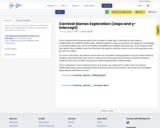
This is a lesson that introduces kids to the concepts of slope and y-intercept as they relate to multiplicative and additive relationships.

Students compare slope as it relates to distance vs. time. Using a simulation on Desmos, students find that faster speeds create steeper slopes on a graph.

This video is part of the Learn and Grow with WHRO TV series. Watch Xenia Clare teach about strategies to determine equality in equations.

This is a digital sort of terms for equations and expressions. Students are able to sort terms the teacher provides, the given equation, and create their own equation. https://jamboard.google.com/d/1xT6VfZwn38OcLnmGz2OsX29ci6jbmN4iCrtqo7JgPT4/copy?usp=sharing
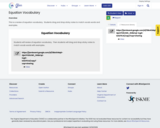
This is a review of equation vocabulary. Students drag and drop sticky notes to match vocab words and examples.
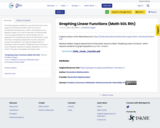
This task requires students to use the fact that on the graph of the linear function h(x)=ax+b, the y-coordinate increases by a when x increases by one. Specific values for a and b were left out intentionally to encourage students to use the above fact as opposed to computing the point of intersection, (p,q), and then computing respective function values to answer the question. The Virginia Department of Education resource titled, "Graphing Linear Functions," which requires students to graph equations in y=mx + b form includes a template and lesson plan.

Video Description: Balancing Earth's incoming and outgoing energy is like balancing an equation. When both are equal, Earth's energy is in balance. Learn more about how changes in this balance may impact Earth. Video Length: 2:56.NASA eClipsTM is a suite of online student-centered, standards-based resources that support instruction by increasing STEM literacy in formal and nonformal settings. These free digital and downloadable resources inform and engage students through NASA-inspired, real-world connections.NASA eClips Real World segments (grades 6-8) connect classroom mathematics to 21st Century careers and innovations. They are designed for students to develop an appreciation for mathematics through real-world problem solving.

Video Description: Earth's energy balance is very delicate. Small changes may have a big impact. How might changes in Earth's land and atmosphere impact this delicate balance? How might this knowledge be used to help us take better care of Earth? Video Length: 2:31.NASA eClipsTM is a suite of online student-centered, standards-based resources that support instruction by increasing STEM literacy in formal and nonformal settings. These free digital and downloadable resources inform and engage students through NASA-inspired, real-world connections.NASA eClips Real World segments (grades 6-8) connect classroom mathematics to 21st Century careers and innovations. They are designed for students to develop an appreciation for mathematics through real-world problem solving.

Video Description: At NASA everything begins with an idea. Physical models help NASA engineers and technicians test those ideas before building full-scale versions. Learn more about the important role physical modeling, building prototypes and mathematics play in engineering solutions. Video Length: 3:11.NASA eClipsTM is a suite of online student-centered, standards-based resources that support instruction by increasing STEM literacy in formal and nonformal settings. These free digital and downloadable resources inform and engage students through NASA-inspired, real-world connections.NASA eClips Real World segments (grades 6-8) connect classroom mathematics to 21st Century careers and innovations. They are designed for students to develop an appreciation for mathematics through real-world problem solving.

This activity is designed to support student learning of solving equations through error analysis. Studnets will descibe in typed words the error and correct the error to solve the equation properly.
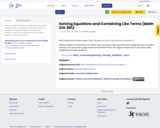
This task requires students to think about equations and solve them using pictures. The VDOE resource provides an additional resource with practice problems, lesson plan guidance, and real world problems solving equations.

This video is part of the Learn and Grow with WHRO TV series. Watch Xenia Claire teach about adding and subtracting in story problems using multiple strategies.

This video is part of the Learn and Grow with WHRO TV series. Watch Xenia Claire teach about adding and subtracting in story problems using multiple strategies.

In this lesson, the students will explore and learn how to translate two step algebraic expressions from words and real-world scenarios. The teacher will engage students in discussion and facilitate their learning as they encounter a variety of learning styles including sorts, self-check games, and drag-and-drop modeling. The attached PDF provides links to the resources and materials.
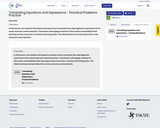
OverviewIn this lesson, the students will explore and learn how to translate two step algebraic expressions from words and real-world scenarios. The teacher will engage students in discussion and facilitate their learning as they encounter a variety of learning styles. The attached document provides links to the resources and materials.